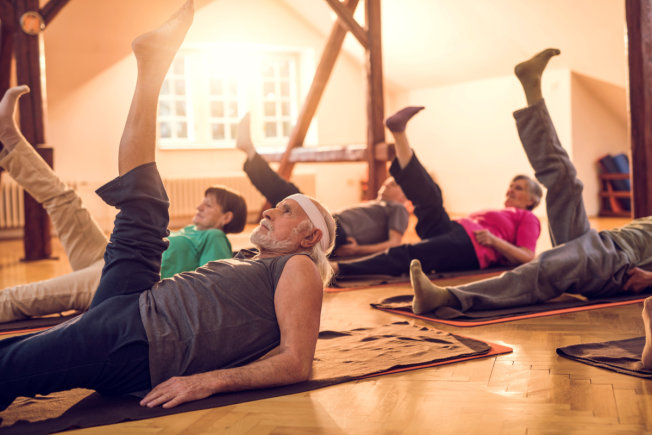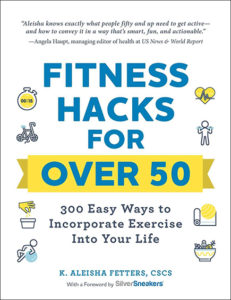
‘Strength is the fountain of youth.’
Strength training isn’t just for bodybuilders and marathoners. It’s for anyone who wants to feel healthier, more energetic and, yes, younger.
“Strength is the fountain of youth,” says Gavin McHale, a Winnipeg-based kinesiologist and certified exercise physiologist who works primarily with older adults. “Benefits of resistance training, and subsequent strength gains, in older adults include better control of symptoms of chronic disease, pain and depression, as well as prevention of falls, maintaining existing muscle mass, improving posture and stability, increasing bone density and remaining functional.” For instance, a 2015 Experimental Gerontology study of men and women ages 65 to 97 in retirement care facilities found that performing strength exercises just two times a week for six months significantly improved participants’ mobility and functional performance. The result: a longer and, most importantly, fuller life.
After all, as we age, while we naturally lose some muscle mass because our muscles become less sensitive to dietary protein’s muscle-building ways and changing hormones, a decline in physical activity is the biggest culprit. Called sarcopenia, this loss of muscle – which begins around age 50 – is linked with low bone-mineral densities, falls, fractures and insulin resistance, which may be an early sign of early Alzheimer’s disease, according to recent research published in Diabetologia.
Luckily, virtually everyone is able to complete strength exercises, as long as they take into account their personal health rather than the number of candles on their birthday cake. “I have clients that are 25 years of age that may need more modifications than 70-year-olds who have been working out their whole life,” says Briana Klein, exercise scientist and founder of Roots of Integrity Holistic Fitness in Chicago. Meanwhile, strength training has helped one of her clients with existing Parkinson’s disease manage her condition and ease symptoms. Everyone has a different starting point.
“Start small. Some is better than none, more is better than some,” McHale says. If you have any limiting conditions such as bad knees, hypertension or a replaced joint, talk to you doctor before beginning any exercise routine.
Here are the eight best equipment-free exercises to get you started, build strength and feel young, no matter your age:
1. Lying Hip Bridges
These work your glutes, your body’s largest muscle group, while also opening up the hips, McHale says. The hips can get especially tight in people who find themselves spending hours sittingthroughout the day.
Instructions: Lie flat on your back with your knees bent and feet flat on the floor. Flatten your lower back against the floor, squeeze your bum and push your hips up into the air. Make sure to push through your entire foot, almost as if you’re trying to push your toes out the end of your shoes. Pause, then slowly lower to start.
2. Squats to Chair
Among the most functional exercises around, squats strengthen the entire lower body and core to help you take stairs, pick things up off the floor and get out of chairs without struggle into old age, he says.
Instructions: Stand with your feet hip-width apart directly in front of a chair. Keeping your chest upright, push your hips back and bend your knees to lower your body toward the chair. Either touch your bum to the chair or sit down on it. At the bottom of the squat, your upper body should be leaning forward only slightly. Pause, then push through your feet and squeeze your bum to return to start.
3. Wall Push-Ups
Improve your whole upper-body strength, especially your arms and chest, with this simple exercise, Klein says.
Instructions: Stand about 2 feet away from the wall (move closer to the wall to make the exercise easier), and put your hands against it at shoulder height and shoulder-width apart. Keeping your body in a straight line, bend your elbows diagonally to your sides to lower your chest to the wall. Let your heels come off of the floor. Pause, then slowly press through your hands to straighten your elbows and return to start.
4. Side Lying Circles
This little move has big benefits: It strengthens your hips while improving mobility through the joint, she says.
Instructions: Lie on one side on the floor with your body in a straight line, your bottom arm extended straight past your head. Rest your head on your bottom arm and squeeze your abdominals to pull in your belly. Keeping your hips directly over each other, lift your top leg to about hip height and move your leg in small clockwise circles in the air. Pause, then perform the circles in counter-clockwise motion. Lower your leg to return to start, and repeat on the opposite side.
5. Quadruped Opposite Arm and Leg Balance
This exercise is great for improving balance, coordination and strength in the back and abdominals, she says.
Instructions: Get on all fours with your hands directly under your shoulders and knees under your hips. Keeping your back flat and abdominals tight, lift one hand to reach straight in front of your shoulder while lifting your opposite foot straight behind your hip. Hold for three breaths (or as long as you can maintain balance), and then lower your hand and foot toward the floor to return to start. Repeat on the opposite side.
6. Deadbugs
They have a funny name, but they’ll seriously help you improve your core stability for greater balance and all-over strength, McHale says.
Instructions: Lie flat on your back with your arms and legs up in the air, your knees bent. Maintaining contact between your lower back and the floor, lower one leg until your heel just about touches the floor while also lowering the opposite arm toward the floor above your head. Lift them back up to return to start, and repeat on the opposite side. You can make this exercise harder by keeping your legs straight rather than bent.
7. Side Planks
This plank variation will improve side-to-side core stability as well as strengthen your shoulder, a joint that can give many older adults problems, he says.
Instructions: Start by lying on your side, propped up with your elbow directly below your shoulder. With either the sides of your feet or the sides of your knees stacked on the floor (do what’s comfortable for you), squeeze your core and lift your hips off of the floor so that your body forms a straight line from your ears to either your feet or knees. Hold for as long as you can while maintaining good form. Lower your hips to return to start, and repeat on the opposite side.
8. Wall Angels
Ease back pain and improve your posture by opening your chest and working your shoulders with these simple against-the-wall moves, he says.
Instructions: Stand with your back flat against a wall and your feet about 3 to 6 inches from the wall. With the back of your head touching the wall and your arms straight down by your sides, tuck your chin to your chest. Then turn your palms out and slowly raise your arms, maintaining contact with the floor or wall. Raise your arms as high as you can without your elbows bending or feeling any discomfort. Pause, then lower your arms to return to start.
Fitness Hacks Over 50
Leading a healthier life doesn’t have to be about dramatic lifestyle changes, super-long workouts, or expensive gym equipment. And, for the most balanced, sustainable results, it shouldn’t be! Experience how true lifelong fitness is about integrating movement into your day-to-day, don’t-even-think-about-it routine. Feel your best with Fitness Hacks for Over 50!
